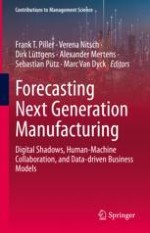Manufacturing companies have just begun to implement the concepts of the Fourth Industrial Revolution (Industry 4.0) on a larger scale. Still, this area is characterized by a rapid pace of technological change, blurring boundaries between physical, digital, and biological systems, and a quickly changing growing political, economic, and social environment -- leading to high uncertainty in decision making and many questions about the future development in this field.
To provide guidance and inspiration for managers and academics on the future of digital manufacturing systems, this book presents the results of an extensive Delphi study on next-generation manufacturing systems, with a projection period of up to 2030. We analyzed almost 2000 quantitative estimations and more than 600 qualitative arguments from a large panel of industrial and academic experts from Europe, North America, and Asia. The book describes each of the 24 projections in detail, offering current case study examples and related research, as well as implications for policymakers, firms, and individuals. The empirical results also allowed us to build scenarios for the most probable future along the dimensions of governance, organization, capabilities, and interfaces from both a company-internal and an external (network) perspective.
